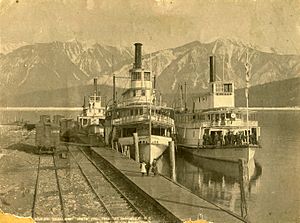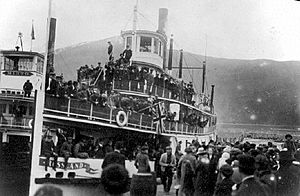Rossland (sternwheeler) facts for kids
The Rossland was a special type of steamboat called a sternwheeler. It sailed on the Arrow Lakes in British Columbia, Canada. This boat was named after Rossland, British Columbia, which used to be a busy mining town nearby.

Rossland (in center), with Trail on left and Minto on right, between 1898 and 1900
|
|
Quick facts for kids History |
|
|---|---|
| Name | Rossland |
| Owner | Canadian Pacific Railway |
| Route | Arrow Lakes |
| Builder | Thomas J. Bulger |
| Cost | $86,000 |
| Launched | November 18, 1897, at Nakusp, BC |
| In service | 1898 |
| Out of service | 1916 |
| Identification | CAN 107142 |
| Fate | Sunk at dock while out of service, January 25, 1917 |
| General characteristics | |
| Type | inland lake boat, express passenger/tourism/general purpose |
| Tonnage | 884 gross; 531.5 net |
| Length | 183.5 ft (56 m) |
| Beam | 29.1 ft (9 m) |
| Depth | 7.0 ft (2 m) depth of hold |
| Installed power | coal-fired boiler, steam engines, twin horizontally mounted, 22" bore by 96" stroke, 32.2 horsepower nominal |
| Propulsion | sternwheel |
| Speed | 22 miles per hour (maximum) |
| Capacity | 300 passengers |
Contents
Building the Rossland Steamboat
The Rossland was the third steamboat built by the Canadian Pacific Railway (CPR). The CPR used these boats on the lakes in the Kootenays region.
Designed for Speed and Comfort
A skilled steamboat expert named James W. Troup designed the Rossland. He was the head of the CPR's Lake Service. The goal was to make a fast boat for passengers and tourists. It was meant to travel 256 miles from Arrowhead to Robson and back in just one day.
Where the Rossland Was Built
The Rossland was built at Nakusp. It was made at the shipyard owned by Thomas J. Bulger and his sons. Most steamboats in the Pacific Northwest had flat bottoms. This helped them travel in shallow rivers to reach mines or farms. But the Rossland was different.
A Special Lake Boat Design
Since the Rossland would mostly be on deep lakes, it had a rounder, deeper bottom. This design made it faster and more efficient on the Arrow Lakes. Its powerful engines were made by B.C. Iron Works in Vancouver.
Life on the Arrow Lakes
After its launch, the Rossland was pulled to a nearby dock by another boat, the Nakusp. This was so it could be finished. Before it carried passengers, the Rossland helped by towing barges. This happened while the Lytton boat was being fixed.
Starting Passenger Service
Passenger trips for the Rossland began in early 1898. It could go up to 22 miles per hour, making it the fastest boat on the lakes. However, going that fast used too much coal. So, it usually traveled at a slower speed.
Dealing with Fires and Winters
Steamboats could easily catch fire, like the Nakusp did in 1897. In 1899, the Rossland itself caught fire near Nakusp. Luckily, Captain Forslund was able to get the boat to shore and put out the flames. Steamboats on the Arrow Lakes only ran during certain seasons. The lakes would freeze over in winter. During this time, the boats were parked safely. Workers would often fix them up for the next season.
Making the Rossland Even Better
During the winter of 1908 to 1909, the Rossland got an upgrade. Its Texas deck, which was the highest cabin area, was made longer. This added more space for passengers. This repair cost $2,290.
Getting a New Hull
The Rossland's wooden hull (the main body of the boat) wore out over time. This was common for wooden steamboats. In the winter of 1909-1910, the Rossland got a major fix. It was brought to the shipyard in Nakusp. The builder, James Bulger, pulled the boat out of the water. He then carefully lifted the boat's cabins and engines onto wooden supports. The old hull was put back in the lake. Then, a brand new hull was built right under the old cabins and engines. Once the new hull was ready, the boat was put back into the water. With a new hull, the Rossland was almost like a brand new steamboat! The Texas deck was also made a bit longer during this rebuild.
The Great War's Impact
When Canada joined the Great War in 1914, many young men from British Columbia joined the army. Many CPR employees volunteered, especially engineers and sailors for the navy. As these young men left, local farms and businesses struggled. Tourism also decreased.
Transporting Troops
In its last few years, the Rossland helped by carrying troops, just like other CPR steamboats. The war caused money problems, so the CPR had to stop using some of its boats. The Rossland was having problems with its boiler. Instead of fixing it, the CPR decided to take the boat out of service.
Sinking at the Dock
On January 25, 1917, the Rossland was parked at the dock in Nakusp when it sank. It might have sunk because its wooden seams opened up. Or, perhaps the heavy snow and ice on its decks pushed it down. Water then poured in through open windows. The boat sank quickly, leaning sharply to its left side. The water reached up to the pilot house.
What Happened Next
The Rossland was pulled out of the water in March 1917. Its long-time captain, Captain Forslund, bought the old hull. He then used it as a floating dock for his place south of Needles.


